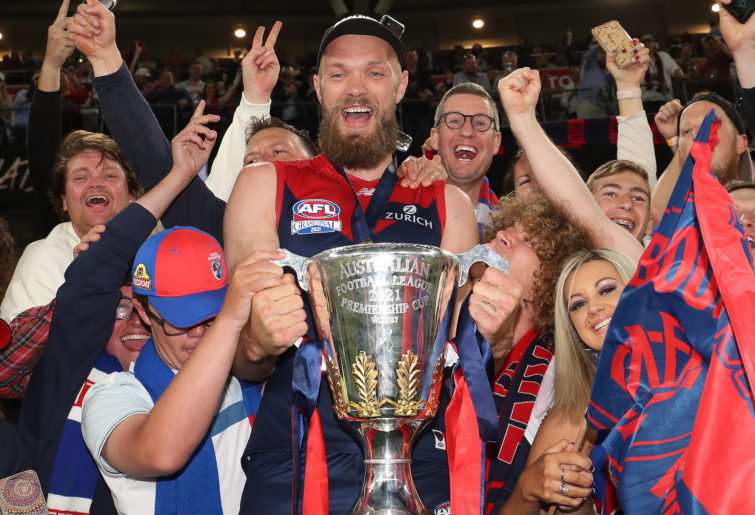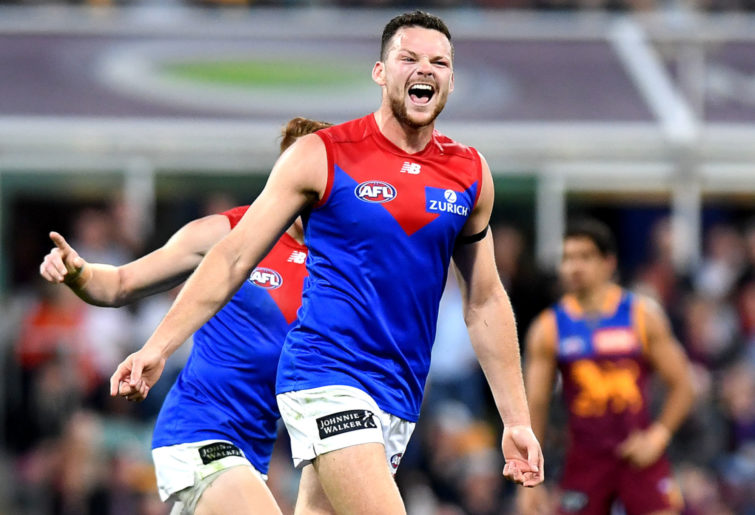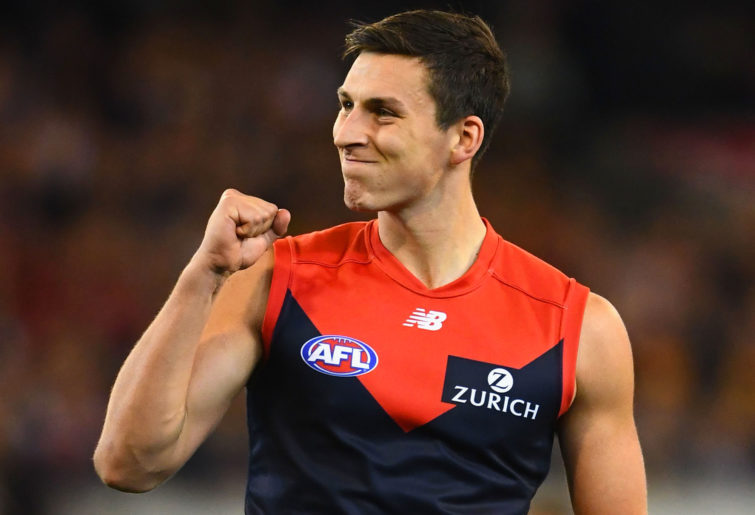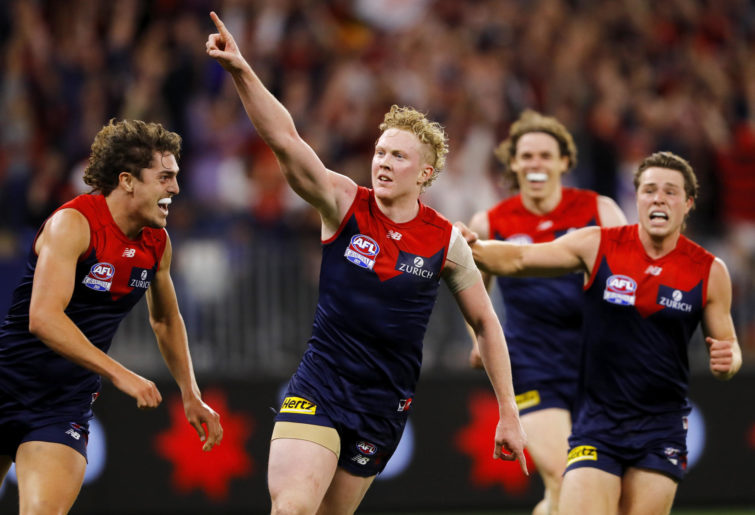Welcome to the final part of my season reviews for season 2021.
Today’s side are the premiers the Melbourne Demons. The Demons became the third side in 20 years to break the historically long premiership drought in a huge win for the AFL’s equalisation measures.
The other two sides are the Swans in 2005, and the Bulldogs in 2016. It leaves the onus on St Kilda to break their drought, which has lasted since 1967.
In this review I will outline what worked for the Demons, what didn’t work (there’s not a lot that didn’t work), questions that remain, and how they can improve heading into next year before finishing off with a dramatically too early prediction for next season as well as a letter grade for their season overall.

(Photo by Paul Kane/Getty Images)
What worked?
Coaching changes
Simon Goodwin entered this season a dead man walking. His papers were practically stamped at the end of last year.
After an ignominious ninth-placed finish in season 2020 the writing was on the wall for Goodwin and his charges. However, much like Damien Hardwick in 2016-17 or even Nathan Buckley, the year after Goodwin experienced a huge reversal of fortunes.
With able assistant coaches around him, the Demons were able to institute an entirely new game style built off of the exemplary intercepting play of their key defenders along with the crisp ball use and gut running on the outside by Ed Langdon and Angus Brayshaw.
The Demons typified the old axiom that a champion team will always win out against a team of champions.
The coaches were able to imbue the Demons with a newfound confidence in one another and the game style enabled the Demons to play like a well-oiled machine instead of having to rely on individual brilliance.
You had Mark Williams, who was integral to developing the ability of the Melbourne midfielders to dispose of the ball proficiently while exploiting the natural aerobic talents of Langdon.
Then there was strength and conditioning coach Darren Burgess, who kept the Demons healthy as they went into the latter stages of the season as well as enabled them to run out games effectively.
Bringing it all together was Simon Goodwin, who was finally able to get the best out of his champion players and break a drought that will surely see him go down in Melbourne folklore.

(Photo by Michael Willson/AFL Photos via Getty Images)
Key defensive structures
I am not just talking about Steven May and Jake Lever here, though that pairing did make a huge difference.
I am referring to the glut of riches that Melbourne have in their key defensive stocks. When Adam Tomlinson went down in Round 5 with a season-ending ACL injury, Harrison Petty took over without breaking a sweat, enabling Lever to continue to play his intercepting role.
Lever orients himself around the deepest key defender Harrison Petty, who frequently matched up on the best key forward in an anchor role rather than any offensive capacity.
Additionally, the Demons also have Michael Hibberd and Joel Smith waiting in the wings, providing the Melbourne back line with valuable flexibility as both can play above their height or lock down the small defenders.
With this factor in play, a Melbourne back line starts to come together that is equal parts defensive and offensive, with the flexibility to match it with any forward line while still enabling multiple players to come in and out.
Moreover, the Melbourne Demons also have a mosquito fleet that can run sides off their feet.
The Demons lost Jayden Hunt before finals, but Jake Bowey and Trent Rivers were easily able to proficiently compensate for the loss in output.

(Photo by Bradley Kanaris/AFL Photos via Getty Images)
Two-ruck system and the midfield
Any midfield that features Max Gawn, Christian Petracca and Clayton Oliver is going to rank among the best in the competition.
So good was the midfield of Melbourne that they frequently took one less at the contested instead playing Angus Brayshaw or Trent Rivers as a defensive wingman/high half back.
This resulted in them having a less than stellar clearance game but it was a sacrifice that they were willing to make.
Then when you consider the blue-collar midfielders like Jack Viney and James Harmes and the depth and multifaceted nature of the Melbourne midfield becomes apparent.
Moreover, the Melbourne midfield is as skilled on the outside as it is tough on the inside with players like Ed Langdon and Christian Salem providing important run and carry along with forward momentum.

(Photo by Quinn Rooney/Getty Images)
Finally we have their two enigmatic rucks, the big-bearded behemoth Max Gawn and the 2021 Rising Star winner Luke Jackson.
Max Gawn plays like a fourth midfielder in the ruck contest, able to push and shove with the best ruckman while still forcing the lumbering gorillas to run around the ground.
For a player that used to have a smoke on the way to training, his efforts have been exemplary and he’s been rewarded with 16 Brownlow votes, a premiership medallion and a new baby.
Then there is Luke ‘Dogga’ Jackson, who besides some false teeth is able to bring the enthusiasm of youth with the mercurial ability that comes with the confidence to try anything.
What didn’t work?
When you’re the reigning premier, there’s not a lot that didn’t work, but I will attempt to outline what the Demons didn’t do so well here.
The machinations surrounding Sam Weideman, Tom McDonald and Ben Brown
The decision to bring in Ben Brown ultimately proved to be a good one as it straightened the Demons up going into the forward line.
However, the Demons took far too long to figure that out and it required a dip in form in the middle of the year to realise they still required some senior talent to straighten the up heading into the forward line.

(Photo by Michael Dodge/AFL Media/Getty Images)
However, the machinations surrounding these key forwards was emblematic of a deeper problem in the Melbourne forward line.
They were outscored in the home-and-away season by the Bombers, Swans, and Western Bulldogs, forcing them to rely on their defence far too frequently and it took a late-season burst of form for this to rectify itself.
Questions that remain
Will this be the start of a Demons dynasty?
Maybe. The hardest thing in football is to remain up consistently as the attrition of the AFL’s equalisation measures begin to feel tougher and tougher to deal with.
They require an enigmatic figure like a Tom Brady who’s willing to take a pay cut in the name of winning championships.
The Demons will be thereabouts again next year. As to whether they can get the whole enchilada, that’s an entirely different matter.
Can they find a spot for Sam Weideman?
Weideman is too good to play VFL footy, that much was clear in his frequent performances of three or more goals.
However, he is a confidence player and has never been given enough time at senior level to show his wares.
The Demons may have erred in extending his contract as it may have been worth trading him out for peanuts to get him the opportunity to show his wares at senior level.

Sam Weideman of the Demons. (Photo by Quinn Rooney/Getty Images)
How can they improve?
More of the same, thank you very much
The Demons have done extremely well in that they’ve built a good young core of players from their years in the wilderness.
Their performances this year reveal a consistency that is tough to beat. Yes, they had their ebbs and flows, and it is still an open question whether this Melbourne side can deal with any sort of pressure that comes with an extensive injury list.
But the Demons outperformed every side in a canter to win this year’s premiership so all I can say is do that but again next year.
Best and fairest: Clayton Oliver
Melbourne have yet to hold their best and fairest on account of going so deep into September.
There are many players that I could pick for the Keith ‘Bluey’ Truscott award, but Clayton Oliver is streets ahead of all his competition.
He turned from a pure inside midfielder to an inside midfielder with a damaging kick whereas previously he butchered the ball.

(Photo by Dylan Burns/AFL Photos via Getty Images)
Grade: A+
It’s not every day that you break a 57-year premiership drought so congratulations to the long-suffering Melbourne supporters, you’ve been through the ringer.
I am giving the Melbourne season the highest possible grade I can as they rode the bumps of the AFL season with aplomb and I expect them to be thereabouts next year.
Way-too-early prediction: First to fourth
The Dees will be up the pointy end of the ladder again as they seem to have a preternatural ability to smash their contemporaries but are less successful against sides down the bottom of the ladder (see: Adelaide).
I expect that given the core of their team are still comparatively youthful and big Max Gawn still has at least two years left in him, the Demons will be thereabouts again next year.
Well, there you have it Roarers. That’s the last review done of this season, now it’s back to watching anime for me.
I’ll probably write something espousing how my Bombers are premiership favourites later this year, and something to do with the draft. I just haven’t decided yet.
I hope you all enjoyed my writing this season, and I look forward to writing many more pieces in the years to come.
Leave your thoughts in the comments below and I will do my best to respond.



































































































